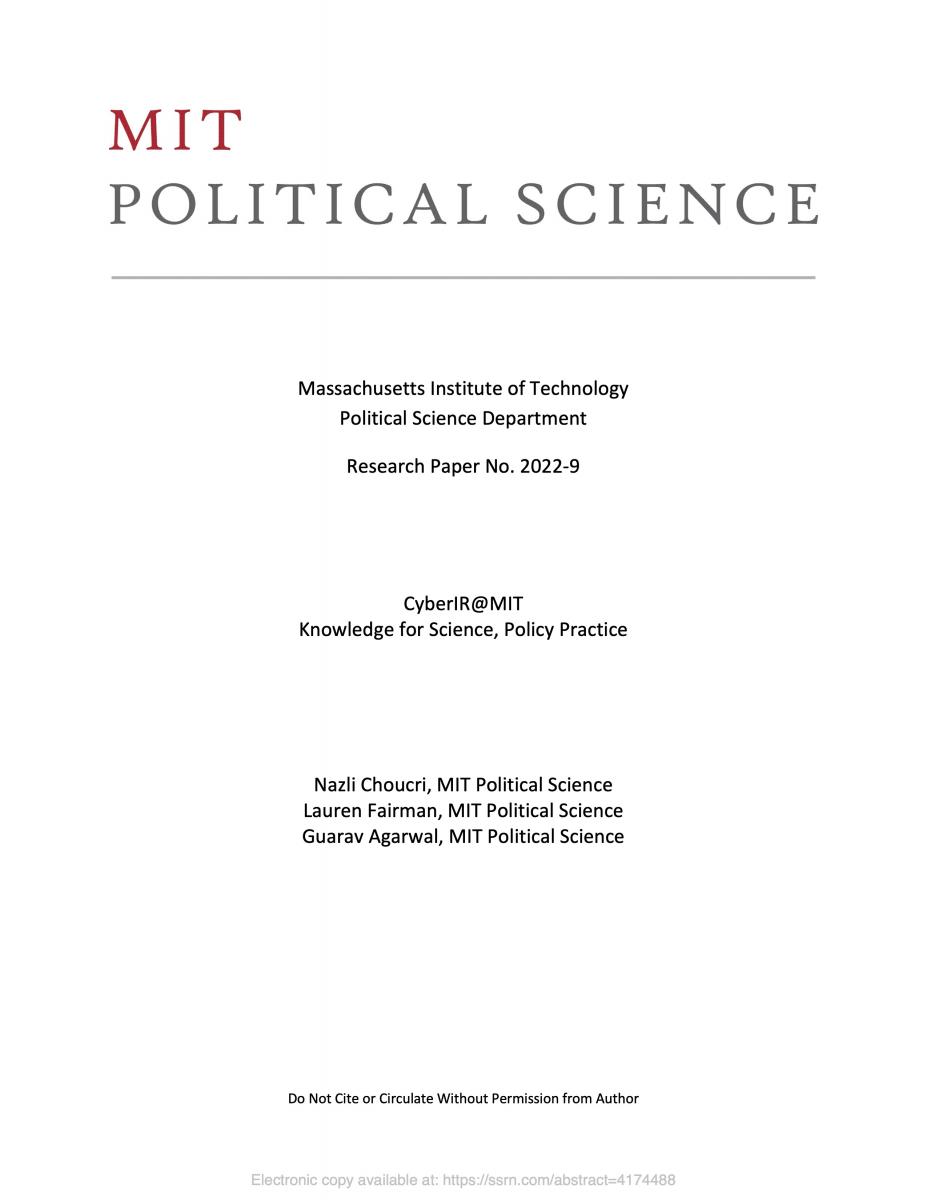See below Expanded Domain ontology for Conflict & War
Dimension 1 -- System State:
1.1 Conflict Systems
- A. Human System
- B. Natural System
- C. Cyber System
- D. Intersections of Systems
1.2 Threat Mode
- A. Conventional Modes
- 1. Kinetic, Military, Undersea
- 2. Biological & Chemical
- 3. Nuclear
- 4. Space & Other
- B. Cyber Centric
- 1. Intrusions & Exploitations
- 2. Cyber Attack
- 3. Cyber-Physical Attack
- 4. Other
- C. Joint Cyber-Traditional Mode
- D. Other
1.3 Threat Actors & Targets
- A. Type & Focus
- 1. Level Centric
- 2. Layer Centric
- 3. Intersection of Level & Layer
- 4. Other
- B. Actors
- 1. Identity
- 2. Intents & Capabilities
- 3. Instruments
- 4. Other
- C. Motivations
- 1. National Security
- 2. Political & Strategic Gains
- 3. Economic & Financial Gains
- 4. Other
- D. Target
- 1. Layer of Internet
- 2. Level of International Relations
- 3. Intersections of Levels & Layers
- 4. Dynamics of Change
1.4 Conflict Dynamics
- A. Capabilities & Hosilities
- 1. Antagonizing Hostilities
- 2. Conventional, Kinetic Activities
- 3. Information, Trade, Markets & Other
- 4. Cyber & Other
- B. Conflict Mode
- 1. Deter & Deflect
- 2. Antagonize & Escalate
- 3. Attack—Initiate
- 4. Other
- C. Overt Cyber-IR Warfare
- 1. Cyber Centric War
- 2. Support to Kinetic War
- 3. Kinetic Centric War
- 4. Other
- D. Impact
Dimension 2 -- Problems Due to Cyber-IR Conflict & War:
2.1 Damage to Natural System
- A. Conventional Warfare
- 1. Direct Impact (Destruction of Terrain)
- 2. Indirect Impact (Destruction of Human-Made Facilities)
- 3. Post-War Remnants
- 4. Other
- B. Nuclear, Chemical, Biological & Other
- 1. Immediate Effects
- 2. Long-Term Effects
- 3. Damages to Life Supporting Properties
- 4. Generativity of Unknowns
- C. Intersection of Damages
- D. Other
2.2 Damages to International Relations (IR) Levels
- A. Individuals & Populations
- 1. Wellbeing & Health
- 2. Habitats
- 3. Life Support Systems
- 4. Other
- B. State Level Damages
- 1. Infrastructure Damages
- 2. Economic Sectors & Financial Damages
- 3. Political Systems Damages
- 4. Social Cohesion
- C. International Level Damages
- 1. Scale & Scope
- 2. Communication, Trade, Transportation
- 3. Damages to Society
- 4. Other
- D. Global Cross Level Damages
2.3 Damages to Layers
- A. Physical Infrastructure
- B. Networks & Communication
- C. Content & Information
- D. Other
2.4 Damage to Governance & Order
- A. International (IR) Levels
- B. Layers of Internet
- C. Intersections of Levels & Layers
- D. Generativity
Dimension 3 -- Technological & Scientific Responses:
3.1 Strengthen Warning & Security Systems
- A. Threat Assessment
- 1. Intelligence
- 2. Detection
- 3. Diffusion
- 4. Other
- B. Communication Protection
- C. Security Systems Protection
- 1. Cyber Security
- 2. Environmental Security
- 3. Society & State Security
- 4. Human Security
- D. Other
3.2 National Responses
- A. Deterrence & Diplomacy
- B. Military & Strategic Responses
- 1. Modes & Responses
- 2. Protection of Information Environment
- 3. Joint Operations
- 4. Other
- C. Cyber Forces Operations
- 1. United States (US)
- 2. US Allies
- 3. Adversaries
- 4. Other
- D. Cyber Forces
- 1. Command and Control
- 2. Cross-Military Operations
- 3. Information Operations
- 4. Other
3.3 Military Engagement
- A. Modes & Responses
- 1. Initiation
- 2. Scalable
- 3. Portable
- 4. Other
- B. Major Operations
- 1. Deterrence
- 2. Offense
- 3. Defense
- 4. Defend Forward
- C. Joint Operations
- D. Other
3.4 Resilience & Capacity Building
- A. System-Wide Focus
- B. Focused & Targeted
- C. Networks
- D. Other
Dimension 4 -- Socio-Economic & Political Responses:
4.1 Enhance Analytical Capabilities
- A. Control Point Analysis
- 1. Process Tracing
- 2. Decision Points & Actors
- 3. Examine System Change
- 4. Other
- B. Modelling & Simulation
- 1. What is?
- 2. What if?
- 3. Problem Focus
- 4. Process Focus
- C. Analytics for Cyber-IR System Resilience
- D. Other
4.2 National Institutional Responses
- A. United States National Measures
- 1. Cyber Security Acts
- 2. Presidential Executive Orders (EXORDs)
- 3. National Defense Authorization Act (NDAA)
- 4. Other
- B. Europe National Measures
- C. Asia National Measures
- D. Africa & Other National Measures
4.3 Response Modes
- A. Diplomacy & Negotiation
- B. Coordinated Emergency Response
- C. Market-Based Measures
- D. Other
4.4 Post-Conflict Initiatives
- A. Rebuilding
- 1. Physical Infrastructure & Networks
- 2. Environmental Remediation
- 3. Security Measures
- 4. Other
- B. Resilience & Restitution
- 1. Repatriation & Safe Supports
- 2. Protection Measures
- 3. Anticipation
- 4. Social Support
- C. Conflict Management
- D. Other



